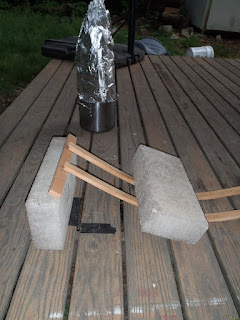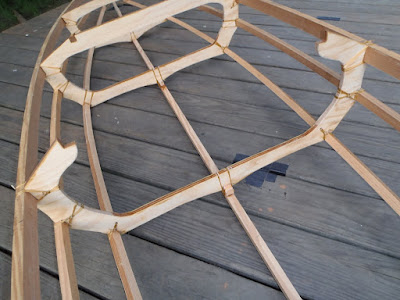Over the last couple of days I put an hour or so into sanding the frame. Ticklish work: sanding each stringer on all four sides without touching the lashings--which would instantly fray. (When I do this with the kids, we will sand the stringers BEFORE we build--in fact, teams of two can each work on their stringer while one team cuts out their frame with the jigsaw and a second team watches to learn how it's done. Phew! -bottle-neck relieved!
A few more things to complete the frame and prepare to skin it:
Bend and install cockpit carlins and deck beam.
Resaw strong-back and make floor boards from it.
Oil frame.
Today I steam-bent the carlins--a skill I'd never really used before. The closest to steam-bending wood was pouring boiling water on gunwales to enable them to make the curve of the deck. This was a bit more official: the carlins (already split for two feet to make bending easier) were suspended in a foil cone over a pot of boiling water for at least half an hour. Then I rushed them (the pliability doesn't last longout to where I'd set up cinderblocks. The ends rested atop cinder blocks and a third weighed down the middle. When I'm done writing this, I'll take them into the garage and see how they fit!
The bending.
You can just make out the are split if you look at the left ends. The steaming apparatus (minus the suspending rope and the pressurized gasoline stove that went underneath) is in the background.
A few more things to complete the frame and prepare to skin it:
Bend and install cockpit carlins and deck beam.
Resaw strong-back and make floor boards from it.
Oil frame.
Today I steam-bent the carlins--a skill I'd never really used before. The closest to steam-bending wood was pouring boiling water on gunwales to enable them to make the curve of the deck. This was a bit more official: the carlins (already split for two feet to make bending easier) were suspended in a foil cone over a pot of boiling water for at least half an hour. Then I rushed them (the pliability doesn't last longout to where I'd set up cinderblocks. The ends rested atop cinder blocks and a third weighed down the middle. When I'm done writing this, I'll take them into the garage and see how they fit!
The bending.
You can just make out the are split if you look at the left ends. The steaming apparatus (minus the suspending rope and the pressurized gasoline stove that went underneath) is in the background.

























